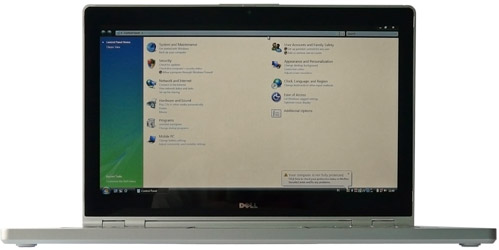Index
Ergonomics, Everyday use
As we said, the layout is heavily affected by the thin design, and there are no connectors on the sides.
![]()
Almost everything is cramped at the back, Ethernet, two plain USBs, one USB/eSata combo, DisplayPort and the power jack. Although Dell didn't hide the connectors under a flap like Apple, we can't say they ruing the Adamo's looks, and the flap on the Air is not a very practical solution to begin with.
![]()
The front and left are connector free.
![]()
On the right side you'll find a SIM slot and audio out.
![]()
The battery is not user replaceable, meaning you're limited to what you can squeeze out of it, and you can't swap it on the go. Mind you, this would not be a problem if you got much out of it, but you simply don't. Although Dell promises battery life of up to five hours, in real life you're looking at under three. We were getting about 2:45 on a regular basis, but if you're more careful you could squeeze out more than three, but not much more. The battery fully recharges in two hours flat.
This means you'll have to carry the AC adapter around quite a bit. Dell obviously had this in mind, as it even designed the adapter in two colour options for the black Onyx and the white Pearl versions. Although it's compact and cute, the adapter isn't perfect. Both ends of the cable are molded to the unit, which makes it a bit more unwieldy than a regular adapter. Also, unlike the Air, it features a classic power jack.
There's a good reason why Apple uses MagSafe connectors. In case someone trips over the cable, they snap out and there's no damage done. In case your clumsy feet decide to snag Dell's power cord, there's a good chance you'll catapult it hurdling through the air like a Navy fighter. However, at some point the Adamo will realize it is heavier than the air, and that its aluminium chassis is not exactly something NACA would classify as an air-worthy airfoil. It will then will proceed to crash to the floor, denting your budget by $2000+ in the process.

The 13.4-inch 1,366x768 LED backlit screen is excellent, and it's one of the best we've ever come across, at least as long as you don't take it out of your house. As you've probably noticed by now, we're not fans of glare screens, and we feel they have no place in ultraportables. Although the screen hidden under a mineral glass cover looks stunning, once you go out you'll be begging for an ugly matte screen. Like most glare screens, it's too reflective, and nearly useless on a bright day. On the other hand, if you're a researcher at an Antarctic science station, go for it, it's great at night.
We know people like shiny stuff, and we know computers like the Adamo and Air put looks before anything else. However, the lack of a matte screen option on either of these beauties simply disqualifies them as an option for many serious consumers who expect more than good looks, and this is an issue all vendors should address. Lenovo offers a matte screen option on its X301, but the X301 is nowhere near the Adamo or Air in terms of design and it's simply not an option if you're looking for a fashionable piece of kit.
Although some people like Lenovo's conservative design, I personally believe that at some point they hired the bloke who designed the ZX Spectrum back in '82, and told him: "Don't change anything. Ever. Just get rid of that rainbow bit in the corner. It's too cheerful, we want everything charcoal black. You can use a bit of grey on the lettering, but not too much." I honestly think that's what all computers would have looked like had Stalin decided not to stop in Germany.
In case you're in any way offended by my dislike of Lenovo's black brick design, don't bother sending me hate mail. I get plenty as it is, mainly thanks to Nick F.
